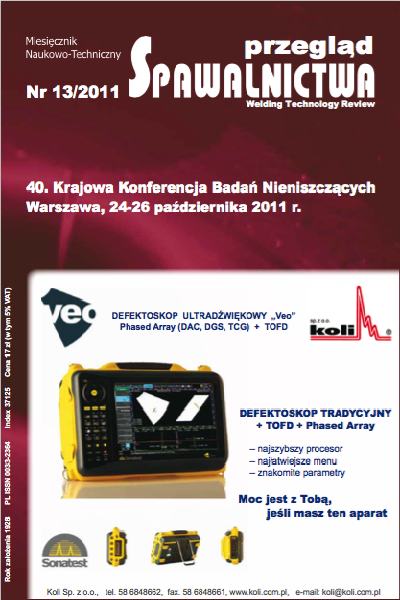Badanie mikrostruktury betonów przy zastosowaniu metody indentacji wielokrotnej
##plugins.themes.bootstrap3.article.main##
Abstrakt
W artykule skonfrontowano wyniki pomiarów parametrów mikrostruktury dwóch serii napowietrzonych mieszanek betonowych, takich jak: porowatość całkowita, współczynnik rozmieszczenia porów powietrznych, odporność na powierzchniowe łuszczenie z parametrami uzyskiwanymi w procedurze indentacji wielokrotnej. Indentacja wielokrotna umożliwia określenie mikrotwardości w obszarze matrycy i obszarze kruszywa, a także wyznaczenie powierzchniowego udziału obszarów o niskiej zwartości (LD), to jest obszarów o wysokiej porowatości. Te parametry uzyskiwane z badania metodą indentacji wielokrotnej można zastosować do oceny trwałości betonów badając np. próbki rdzeniowe, uzyskane z odwiertów. Pomiary metodą indentacji wielokrotnej można prowadzić w sposób zautomatyzowany. Przedstawione wyniki badań wskazują na obniżenie odporności na środowiskowe czynniki agresywne w kompozycjach o podwyższonym współczynniku LD.
Application of statistical indentation method to investigation of concrete microstructure
Abstract
The paper presents the results of investigation of parameters of microstructure of two series of air pertrained concrete mixes. The following parameters were examined: volumetric porosity, air pores spacing coefficient, surface scaling endurance - confronted to those derived from the statistical indentation procedure. That procedure is intended to determine the microhardness of concrete matrix, aggregates area and of the percental content of a component called low density area (LD), characterising the high porosity clusters. The parameters obtained with application of statistical indentation method can be used to assess the endurance of concrete by testing of core samples drilled out of the massive constructions. There is a possibility to automate the described method. The presented test results suggest that the compositions that reveals the increased LD coefficient also tend to demonstrate the lower resistance to environmal aggression agents.
Pobrania
##plugins.themes.bootstrap3.article.details##
Creative Commons CC BY 4.0 https://creativecommons.org/licenses/by/4.0/
Artykuły czasopisma Welding Technology Review (Przegląd Spawalnictwa) publikowane są w otwartym dostępie na licencji CC BY (licencja Creative Commons Uznanie autorstwa 4.0 Międzynarodowe). Licencja CC BY jest najbardziej otwartą dostępną licencją i uważaną za „złoty standard” w formule otwartego dostępu; jest również preferowany przez wielu fundatorów badań. Licencja ta umożliwia czytelnikom kopiowanie i redystrybucję materiału na dowolnym nośniku i w dowolnym formacie, a także zmienianie, przekształcanie lub budowanie na nim materiału, w tym do użytku komercyjnego, pod warunkiem wskazania oryginalnego autora.
Bibliografia
Glinicki M.A.: Trwałość betonu w nawierzchniach drogowych, Instytut Badawczy Dróg i Mostów, zeszyt 66, Warszawa 2011.
Sorelli L., Constantinides G., Ulm F.-J., Toutlemonde F.: The nanomechanical signature of Ultra High Performance Concrete by statistical nanoindentation techniques, Cement and Concrete Research, 38/2008, s. 1447-1456.
Igarashi S., Bentur A., Mindess S., Microhardness testing of cementitious materials, Advanced Cement Based Materials, 4/1996, s. 48-57.
Kasperkiewicz J., Sobczak M.: O możliwościach oceny wytrzymałości betonu na podstawie badania mikrotwardości, Cement-Wapno-Beton, 3/2004, s. 138-142.
